|
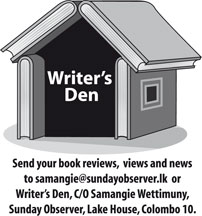
Survey of Lanka’s artistic heritage
Reviewed by Prof. Jayadeva TILAKASIRI
Sri Lankave Nuthana Sittaru is a well-timed and relevant survey of
outstanding artists displaying their own styles and talents in a
kaleidoscope of figures and objects offering a wide range of
contemporary local art, rarely brought into the reader’s spectrum, not
only to entertain but also to reveal the hidden history of our
accumulated artistic heritage.
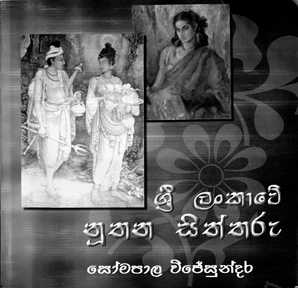 |
|
Sri
Lankave Nuthana Sittaru
Author: Somapala Wijesundara
Publisher: Dept. of Cultural Affairs
Price: Rs. 600 |
As the book covers a wide and appropriate assemblage of nearly 150
artists whose works and output are pooled together, the task of a
reviewer seems to be onerous as he has to keep in mind the presenter’s
aim of conveying the overall quality and aesthetic appeal on judging the
mix of images unlike critically examining a novel or narrative based on
a running theme ending in a finale or the plot of a drama.
Somapala Wijesundara who commenced his career as a Deputy Director of
Art in schools, made maximum use of his travels and experience in
foreign lands working along with eminent directors of the Education
Ministry. His study in foreign institutes of art where art and sculpture
had been included in the curriculum of schools to enrich the
appreciation of art to give the students a comprehensive training in art
and also appreciation of training in the early stages of education in
several schools for disabled children and youth centres in Eastern
European cultural centres is mentioned specially. He had visited the
special art institutes in Russia and gained valuable knowledge and
application of training in art for development of youth and their skills
in improving ability in art-based studies and exhibition of art
compositions.
As his compilation demonstrates he has not merely cultivated his
artistic and creative skills for professional purposes such as
competitions and exhibitions, but also pioneered the teaching of art and
reached a high level of proficiency in developing the interest and
aptitude for art work among students of varying ages.
As a school instructor he has been successful in achieving a high
standard as art educator among schoolchildren in his residential
environs of Anuradhapura and also in Rahula College, Matara, where he
rendered a valuable service to students and staff to popularise art and
its value as an educational aid. He was able to demonstrate his ability
as a competent teacher to elevate the standard of art studies and
promote the appreciation of art as he was endowed with a three-year
training and education in art and sculpture at the former Govt. School
of Fine Art. With his training and maturity of skill in the subject he
was able to organise workshops for teachers, exhibitions and seminars
for the benefit of not only students but also for the promotion of
interest in our traditional contributions by well-known Sri Lankan
artists.
It is therefore our opinion that he has combined the roles of artist
creatively with his output in the field and in the dissemination and
exposition of the developments of art and sculpture during the ancient
and present periods of art education.
As he has developed this dual role of creative artist and critical
writer and commentator his contribution to the preservation of our
collections and displays of selected works of our own talented artists
he deserves our commendation and his effort to preserve the work of
artists in this publication would serve the cause of recording a section
of our art history is indeed highly valued.
It is not possible to evaluate the contents of his impressive
‘gallery’ of artistic reproductions separately which, in my view, covers
almost all the distinguished painters in the field. He has made a very
careful study of the works and the artists, living as well as not
living, in order to show the evolution of Sri Lankan Contemporary Art
from the early paintings on walls and canvas of Sarlis Master and Solias
Mendis and appropriately ending the series with the modern creations of
Justin Deraniyagala.
This mode of selection of the paintings also testifies to his
competent judgement of artists and the influence senior and gifted
painters exercised on their younger aspirant hopefuls all of whom had
received sound training under the Arts School’s teachers.
Although an attempt cannot be made to assess each contribution of an
artist (the author takes up) in this short review it would be
interesting to see the inter-connections between the works of masters
and the younger or even less well-known trainees and the collective
assemblage of the entire output (in the compilation) as a recorded
documentation of contemporary painting of the country’s artists
producing a variety of styles and techniques by means of this effort of
Somapala Wijesundara.
Nevertheless, it is tempting to quote a few artists by name such as
the master creative exponent, George Keyt, whose work illustrates the
fusion of Western concepts and Indian elements of music and theory into
composite pictures of unique appeal. Passing on the author takes up
another maestro, J. D. A. Perera, artist-cum-critic, considered one of
the country’s best Portrait painters in oil colour medium.
His influence is unfailing on those to follow as he graduated into a
professional expert and organiser of such groups as the Ceylon Art
Circle and offering guidance and direction in the promotion of a high
standard of development of art and sculpture collaborating with eminent
officials in the music and performing areas.
As my review would be too long it is necessary to refer to a few
other outstanding and highly recognised artists like Stanley Abeysinghe,
who received the benefit of study and training abroad in foreign art
academies and imparted their knowledge to students here. David Paynter,
W. G. Beling, Ivan Pieris, Mudliyar ACGS Amarasekera and other
distinguished artists who brought out their talents and contributed
individual styles of art production are also comprehensively evaluated
and the entire work of the author is an accomplishment of which he
should feel elated as Modern Art in Sri Lanka recorded here rivals any
such study of modern art elsewhere.
The author states that publications in Sinhala do not cover these
contributions generally as the market is limited.
He has thoughtfully made his detailed and historical study available
to readers and also teachers at a reasonable price making the account
very readable and educationally important.
The Dept. of Cultural Affairs also deserves our appreciation for
undertaking to publish this contribution to understand modern art and
value it.
The writer is Emeritus Professor of Sanskrit and Atg. Vice Chancellor
University of Ceylon, Peradeniya.
Authentic text book on English
Reviewed by R.S. Karunaratne
Although there are many books to help students to learn English, most
of them are foreign publications. These books are helpful for those who
have studied the language to a certain extent. Today it is not possible
to teach pure grammar as it would be rather uninteresting. Gone are the
days when students had to memorise grammatical rules and do a lot of
exercises. For instance, “English Grammar and Composition” by Wren and
Martin was ideal when the medium of instruction was English.
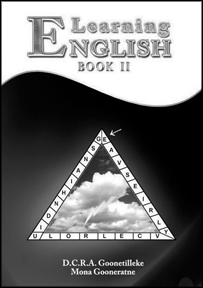 |
|
Learning
English Book II
Authors : D.C.R.A. Goonetilleke and
Mona Gooneratne
Vijitha Yapa Publication
Price: Rs. 250 |
With the passage of time, we have a generation of students who study
in the Sinhala or Tamil medium without even a basic knowledge of
English. For them, teaching English poses many problems. These students
do not wish to follow grammar courses. They want to learn the language
fast and to pass examinations.
“Learning English Book II” has been complied by the two authors to
help students to pass the G.C.E. O/L examination and to learn the
intricacies of the language through interesting passages, stories and
poems. The student can read the passage or the poem and answer
questions. Grammar is then explained in a painless manner so as to
encourage the student to do further studies.
Those who wish to use this book should read and do all the exercises
in “Learning English Book I” published some time ago. These two books
have been compiled in such way that they can be used in the classroom.
If necessary, they can be used for self-study. Book II can also be used
as a source book for spoken English which is popular among the student
population. The dialogues are so interesting that the student will pick
up the spoken idiom quite effortlessly.
The book is full of vocabulary exercises, rhyming words, similes,
comparison of adjectives, prepositions, active and passive voice,
writing paragraphs, letter writing, question forms and a clear
explanation of relative clauses. Many students do not have an
understanding of the basics and as a result they fail in English in the
G.C.E. O/L examination. Books of this nature will help such students to
pick up the language skills without much effort.
“Learning English Book II” is undoubtedly the best book written on
the subject in recent times. The authors Emeritus Professor of English
D.C.R.A. Goonetilleke and Mona Gooneratne - have done a yeoman service
to those who are interested in learning English from a reliable source.
‘Noble war games’:
To unleash the collective unconscious of the people
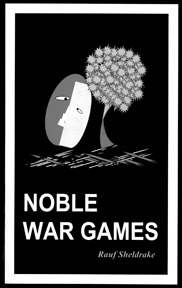 |
|
Noble War
Games
By Rauf Sheldrake
Author Publications,
Printed by M.D.Gunasena and Company Printers |
As Ravin P. Templar has mentioned in the preface of “ Noble WarGames”,
through this novel the author is looking at the perspective of the
defence of the country using the game theory propounded by by two Nobel
laureates, Thomas Shelling and Robert Aumann in 2005 in the use of this
theory in Economics as Conflict Resolution.
“He uses tactics suggested in game theory introduced by these Nobel
laureates, to take the reader beyond the future of counter-terrorism and
instability torn era of effective defense against terrorism by
strengthening the secret service.
”As Templar further mentions the author in a subtle way has
incorporated the growing importance of platonic relationships in our
everyday lives to step beyond conflict and indifference to a horizo nof
unity and prosperity.
The author finds that the majority of those living in the Indian
Sub-Continent, who have been kept less educated by their former leaders
have gotten socially conditioned to think in old fashioned ways.
As stated in the back cover the author has been able to suggest a set
of amusing and innovative ideas that future leaders may want to
implement in an attempt to defend the island against terrorism
.“He takes the reader through the journey of the hero to unleash the
collective unconscious of the people, reinventing the heroes, the
warriors and the inherent wizard in the social mind he attempts to
reinvent the Lanky spirit in us all.
Rauf Sheldrake is a trained accountant with over 17 years of
international exposure in cost cutting, restructuring and trimming
corporates enabling them to perform better.
However, he did not feel, good when his decisions resulted in many
people being laid off from their jobs. In order to express his hurt
feelings , he began to write poems and short stories.
A masterpiece of Sri Lankan war literature
Reviewed by Jayashantha JAYAWARDHANA,
The guerilla war waged by the Liberation Tigers of Tamil Eelam (LTTE)
for a separate state for Sri Lanka’s Tamil community against the
government security forces and lasted for nearly three decades and
dragged to a close on May 18, 2009 with the killing of the Movement`s
leader, Velupillai Prabhakaran is arguably the most significant event in
our post-independence history.
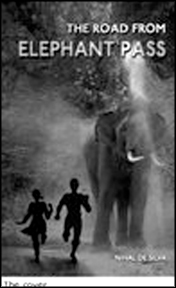 |
|
The Road
from Elephant Pass
Author: Nihal de Silva Vijitha Yapa Publications |
No doubt, it led to unthinkable carnage both in and outside the
battle-field and took the lives of many great men. At the same time, it
wrought irreparable damage to the socio-political fabric of Sri Lanka.
Its influence on our political landscape, economic climate, social
discourse, education, culture and literature is remarkable more for
worse than for better.
When it comes to the influence of this ethnic strife on our
literature, two English novels stand prominent among a host of other
books, both of which have been awarded the Gratiaen Prize offered by the
Gratiaen Trust established by the Sri Lankan born Canadian author,
Michael Ondaatje after winning the Booker Prize for his novel, ‘The
English Patient’ . Those two novels are ‘Sam`s Story’ by Captain Elmo
Jayawardene and ‘The Road from Elephant Pass’ by Nihal de Silva. The
latter draws even more on war and its influence on the individual as its
plot is unravelled. Also, it was awarded the State Literary Award in the
same year (2003).
Incidentally, it is a tragic irony that Nihal de Silva himself was
killed in a land-mine blast at Wilpattu National park.
De Silva, the author is a product of St. Joseph`s College, Colombo
and the University of Ceylon. He ran his own business dealing in the
purification of water and the supply of mineral water. Starting with
‘The Road from Elephant Pass’, he delivered three novels in three
successive years.
Although this was his maiden novel, it earned him both the Gratiaen
Prize and the State Literary award in 2003. In the words of Prof.
D.C.R.A. Goonethilleke, an eminent scholar in Sri Lankan Literature in
English, “....he (Nihal de Silva) is a phenomenon embodying the essence
of recent efflorescence of Sri Lankan literature in English.....” The
novel starts with Captain Wasantha, the narrator of the story and one of
the two protagonists of it waiting for a woman, a senior Tiger activist,
who, his boss Major Kiriella says, has vital information and wants to
negotiate a deal with the S.L. army. Reluctantly though, the former
takes up the assignment of picking up her from a checkpoint at Palali
and taking her to Jaffna. Kamala Velaithan, his charge, turns up but
much later than he expects her to. Perhaps, it is her delay that changes
their lives so dramatically. With her revelation that the Tigers were to
launch an all-out offensive against the army camp at Elephant Pass, it
all turned darker, harder and more dangerous for both of them, for the
woman soldier accompanying them and for Piyasena, their driver.
Practically stranded in the hostile terrain, Captain Wasantha has
little choice but to follow advice offered by Kamala to whom it is no
alien landscape. But, is this woman Tiger all that trustworthy? Is her
information so reliable that he should undertake a perilous trek through
the dense forests of Wilpattu National park to take her to Colombo via
Puttlam? Set against one of the darkest periods of our recent history,
‘The Road from Elephant Pass’ is a novel where the ruthlessness and the
brutality of the ever-worsening conflict is in sharp contrast to the
human values like love, forgiveness, kindness and compassion. It tells
us how people forced by the irreconcilable circumstances take up arms
against their brethren on the other side and imperil themselves to
pursue the elusive dream of a separate motherland. In a sense, it
manages to estimate and explain the human cost of conflict while
occasionally hinting at the hypocrisy of the leaders on either side,
which is totally discordant with the lofty ideals they pretend to stand
for.
The author, it seems to me, has a comprehensive understanding of the
reasons that stoked the burning conflict on either side. He is aware of
the inevitable consequences of the riots of July 1983. He is aware of
the upshot of dirty politics of the narrow-minded leaders from the South
hell-bent on self-aggrandizement. He is aware of the difficulties
encountered by the government armies as they fought the Tamil Tiger
rebels. In short, he is aware that, in the final analysis, the country`s
ethnic problem has political roots.
With his thorough understanding of the nature and the scale of the
country’s ethnic strife and with his remarkable ability to devise
ingenious plots and tell marvelous stories, Nihal de Silva has written a
great novel, which, by any standard, is a masterpiece of Sri Lanka`s war
literature. I am certain few readers will dispute the validity of the
citation awarding it the Gratiaen Prize and delivered by the panel of
judges-Shermal Wijewardene, Priya David and Lakshman Gunasekera: “For
its moving story, for its constant feel of real life, for its
consistency of narrative momentum, for its descriptive power, for its
dramatic use of dialogue to define social context, capture character
psychology and trace the development of a relationship, for its
convincing demonstration that resolution of conflict and reconciliation
of differences are feasible through mutual experience and regard, and
last though not least, for its eminently civilized handling of the last
degree of intimacy between a man and a woman, our choice for the 2003
Gratiaen Prize for creative writing in English is, unquestionably, ‘The
Road from Elephant Pass’ by Nihal de Silva.”
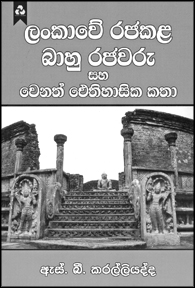 Book launch Book launch
“Lankave Rajakala Bahu Rajavaru
“Lankave Rajakala Bahu Rajavaru Saha Venath Aithihasika Katha”
S. B. Karalliyadde’s ‘Lankave Rajakala Bahu Rajavaru Saha Venath
Aithihasika Katha” will be launched at Dayawansa Jayakody Book
Exhibition Hall, Ven. S. Mahinda Mawatha, Colombo 10 on Tuesday,
November 10 at 10 a.m.
The book will be useful to students studying history.
“Lankave Rajakala Bahu Rajavaru Saha Venath Aithihasika Katha” is a
Dayawansa Jayakody publication.
|

